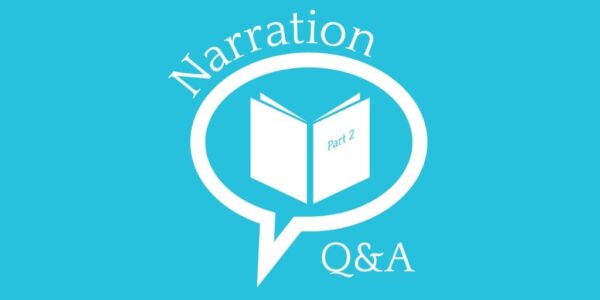Free shipping on USA orders over $129!


We just returned from a homeschool convention in Texas that required four days on the road and three days at the convention hall. You do the math.
During those days away from home, we ate in many different restaurants, and I noticed a trend among the informal ones. As we came in the door, an employee would call out, “Hello, welcome to (insert name of restaurant)!”
But I never felt welcomed. You see, the employee never established eye contact, never smiled at us, never even identified herself. In fact, I often had to look around in confusion to see who might have hollered at us.
It’s true that the employee was performing the required action—greet everyone who comes in the door and say such-and-such—but the purpose seemed to be lost. She knew what to do, but the Why behind it was missing; so her efforts ended up being an exercise in futility. Rather than feeling welcomed, I felt confused and a bit uneasy.
As we begin this Q & A series on narration, I think we need to start with the Why behind the How. You see, we can spend weeks discussing various techniques and how-to’s until you feel confident in what to do, but if you don’t fully grasp the reason Charlotte Mason used narration, your efforts may end up being an exercise in futility.
Why Narrate?
Many children wonder why we ask them to retell what was just read.
Narration Question #1: I always get the question from them, “Why do I have to tell it to you when you just read it?” I read everything to them right now.
It’s a legitimate question. If the narration were for your benefit, as the teacher, telling you what you just read wouldn’t make much sense.
But the truth is that narration is for the student’s benefit.
The mental work of narration—remembering, comprehending, organizing, sequencing, and forming into your own words—is a powerful tool! Information can enter your child’s mind, but until that child works with it, processes it, and makes it his own, he doesn’t really know it.
Narration helps the student make it his own; it helps him cement that information in his mind. It helps the student know.
That’s why Charlotte called this process “the act of knowing.”
“They must read the given pages and tell what they have read, they must perform, that is, what we may call the act of knowing” (Vol. 6, p. 99).
To truly begin to understand the power of narration, you might want to try it for yourself. Take what you have read in this post about the reason we ask students to narrate, and (without looking back) put it into your own words so you can explain to your children the Why behind the How.
“Whatever a child or grown-up person can tell, that we may be sure he knows, and what he cannot tell, he does not know” (Vol. 6, pp. 172, 173).

I think I will be sharing this with my oldest! 🙂
I’m discouraged with narration and my 9-year-old. I’m using a classical education textbook and the sample narrations it gives don’t resemble what my daughter narrates back to me. Hers are far less perfect. I am wondering how structured you think narration instructions should be? Is it too structured to ask a 9-year-old to narrate the story in no more than three sentences—an in one go? We often have to do a “rough draft” narration first, and then revise (as they are written narrations). I worry that the frustration is building and possibly spoiling a love for writing, no matter how patient I am with trying to help her develop her narration skills.
In my experience, the classical education examples of narration are pretty sophisticated. CM is a gentle method. I would like to hear what Sonya or someone from SCM would say, but I personally would try a different approach or two — perhaps oral narration and/or only revising occasional narrations. I think of narration as a marathon (that is, we’ll be practicing it for many years), and there is plenty of time for improvement.
Answered in Part 9 of the Narration Q & A series.
I did my first oral narration with my 9 year old son today after watching (and being SO encouraged) by the living and learning DVD set. He did pretty well, but most importantly, he enjoyed it and twenty minutes later came up to me and said, “the stuff I told back to you is stuck in my head!”
By the way, we have been classical-ish for the last two years and used Story of the World. I was, like the previous poster, always so frustrated that his summaries never sounded like either of the two samples given in the book. CM narrations are more gentle and more doable because there is less pressure to present a product (give three and only three sentences that synthesize the 7 pages of material we read).